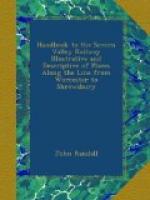“On Wednesday next, Harry,
thou shall set forward;
On Tuesday, we ourselves will march.
Our meeting is Bridgnorth; and,
Harry, you
Shall march through Gloucester;
by which account
Our general forces at Bridgnorth
shall meet.”
Charles I. arrived here from Shrewsbury, October, 1642, when he remained three days and gave expression to the eulogium, which townsmen quote for the benefit of strangers, respecting the beauty of the castle walk. It was garrisoned for this unfortunate monarch, too, in the struggle which cost him his head, upon which occasion the town was stormed by three divisions of the Parliamentary army, March, 1646. The fight waxed hottest near the north gate, and in the old churchyard, where the leader of the loyalists fell. That the adherents of the king were not “all on one side,” would appear from the fact that the town’s defenders were pelted upon retiring to the castle by the inhabitants, treatment which they seem to have deserved in setting fire to the town, bombarding St. Leonard’s, burning the adjoining buildings and driving the wretched population in search of such shelter as the rocks and woods afforded.
The garrison capitulated on the 26th of April, 1646, in consequence of a mine, by which the Parliamentary leader proposed to blow up the castle and set fire to their magazine, then in St. Mary’s Church, which stood within the castle walls. Ecclesiastical dignitaries often then wore coats of mail as well as cassocks, and daggers in addition to their girdles; and this old church being collegiate, had for one of its deans Rivallis, who forged the charter and seal of Henry III., by which the Irish possessions of the Earl of Pembroke were invaded, and that nobleman cruelly treated and killed. The more distinguished William of Wykeham, who held the Great Seal in the reign of Edward III., and exercised considerable influence in his day, both in church and state, was also a dean of St. Mary’s.
St. Leonard’s occupies a position at the opposite extremity of the town. Its crumbling tower, shattered by the cannon of Charles’ army, remains, but the nave and side aisles have recently been restored—that on the south side at the sole expense of John Pritchard, Esq., M.P., in memory of his brother. The celebrated divine, Richard Baxter, began his ministry at St. Leonard’s, apparently with little success, as he is said to have shook the dust from his feet upon leaving, declaring the hearts of the inhabitants to have been harder than the rock on which their town was built. Nevertheless, he afterwards dedicated his well-known book, “The Saint’s Rest,” to them. Adjoining the churchyard is a hospital for ten poor widows, built and endowed, as a brass plate over the entrance informs us, by a relative of Colonel Billingsly, who fell in the service of “King Charles ye First,” and whose sword is said now to be in the possession of a descendant of the family, in the parish of Astley Abbots.




